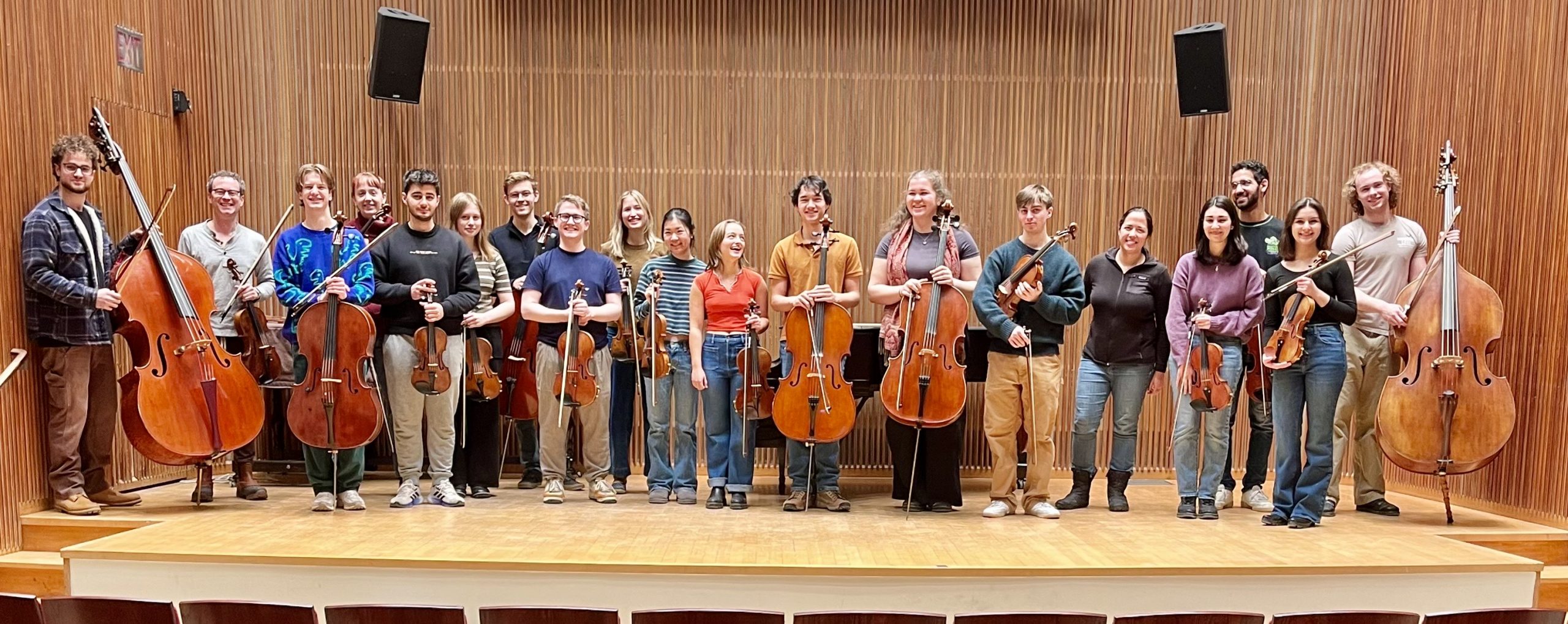by Kate MacKenzie
In black, white, blue, and brilliant red, the Cardinal Chamber Orchestra took the stage of Warner Concert Hall on Sunday, February 2. Notably absent from the group of musicians was anyone with a baton.
The string ensemble was the vision of violist Christopher Broyles, who was inspired by his experience attending the concerts of the conductorless orchestra A Far Cry. “They’re some of the most gripping performances in Boston,” he reported. “Because everyone is completely engaged and active in the result, it’s more exciting on the whole. It’s not one person’s dictatorship, but a melting pot of ideas.” Broyles spent the past year developing that vision into a three-week string orchestra intensive taking place during Oberlin’s Winter Term.
To learn from the best, Broyles brought Jason Fisher and Hannah Collins of A Far Cry to Oberlin for a week-long residency. Under the guidance of the “Criers,” students refined the sensitivity and leadership necessary to rehearse and perform unconducted. In rehearsals, the two often joined the ensemble onstage. “Jason would lead the whole orchestra from last chair viola,” Broyles described. “He was a presence that everyone wanted to follow.”
The following week, the ensemble took their work on the road for a series of community events. Broyles was careful to tailor the engagements to best serve each audience. “We wanted to get away from showing up, playing, and leaving. That’s one kind of community service, just bringing art into people’s spaces. But we really wanted to make what we’re doing relevant to as many people as possible.”
At the Kendal at Oberlin retirement community, this mission took the form of an open rehearsal where attendees could offer suggestions to the musicians. At the Oberlin Public Library, it was a collaborative presentation with the Allen Memorial Art Museum. Other days, it was an instrument demonstration for preschoolers, coachings for the Northern Ohio Youth Orchestra, and a concert for the inmates of the Grafton Correctional Facility.
For many of the students, these performances were the most influential part of the intensive. “It feels good to go out in the community and share the things we love with as many people as possible,” Broyles said. “But it also benefited our playing. We realized what a privilege it is to be musicians and to share great music with as many people as possible.”
It wasn’t until Sunday’s concert that Cardinal performed their full program for the first time. They opened with Danzas de Panama by Oberlin alum William Grant Still. Though distinct in character, the four short movements were united by a sense of contrast between airy melodies and grounded percussion. From the wooden knocks of the Tamborito to the bouncing ricochet of the Mejorana to the rousing bass slaps of the concluding Cumbia y Congo, the “percussion” was the constant heartbeat of the piece. Group energy sometimes ebbed, but the ensemble still demonstrated their skill as a unit in several thrilling accelerandos and dramatic shifts of mood.
The premiere of commission Reel Rebellion followed, written by composition student Matthew Thomas Brown. The piece opened compellingly, a bright violin ostinato paving the way for a syncopated, folk-inspired melody. Momentum wore off through an overlong passage of repetitive dialoguing, and the underwhelming ending lacked the compositional finesse with which the piece began. Still, it showed ingenuity and an excellent ear for balanced string writing.
The heart and soul of the program was its finale: Tchaikovsky’s Serenade for Strings. From the first resonant notes of the opening chorale, it was clear the ensemble was performing at a new level of cohesion and artistry. Overcoming some rhythm issues in the cellos, melody lines were passed seamlessly from section to section in the “Pezzo in forma di sonatina.” A charming “Valse” came next, then a gentle “Elegie” of long, buttery-smooth phrases and a satisfying “Finale (Tema russo).” The whole work had a skilled polish and natural grace that had not previously been demonstrated.
The piece was all the more enjoyable for the obvious engagement of each of its performers. “Hopefully, you’ll see an orchestra of twenty conductors who love every minute of the music,” Broyles had said the day before. In the Tchaikovsky, that vision came to life.
Photo credit: Adan Caldera Quintero
Published on ClevelandClassical.com February 12, 2025.
Click here for a printable copy of this article



